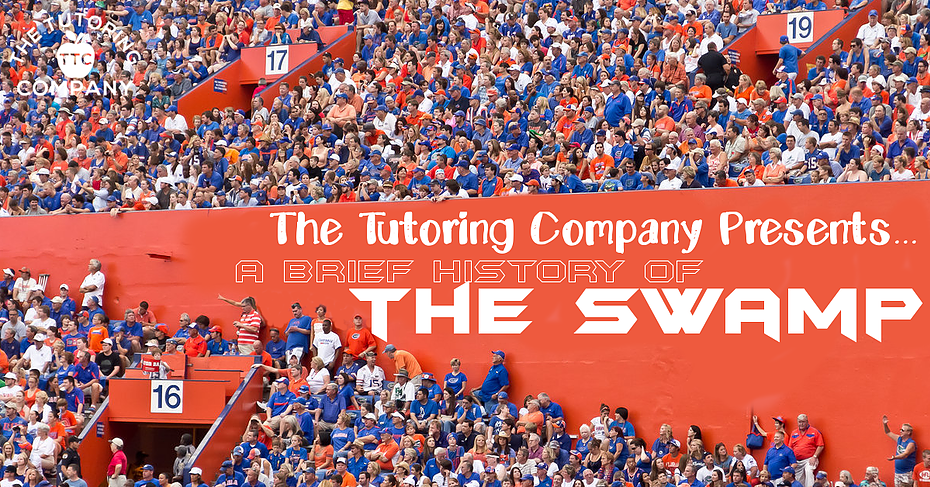The Tutoring Company will be running a series of brief history articles on topics of interest in the areas we serve.
‘The Swamp…Only Gators Get Out Alive…’ As the video rolls and the speakers pound, the crowd erupts and the team flies out of the tunnel. A giant conglomerate of steel, cement and rebar is transformed into a place of worship and fellowship for residents of north central Florida and beyond. Ben Hill Griffin Stadium, far more recognizable by its now ubiquitous moniker, has become a symbol of the University and to a certain extent, the town itself.
Before the University of Florida became a football powerhouse, better known for its performance on the gridiron than its stellar academic and medical merits, its football squad shared a field with the school’s baseball and track teams. Known as ‘The Ballpark,’ the field would serve the gridiron Gators from 1906 to 1911. By 1911, the football team was ready for a move. Trees were cleared on University Avenue and Fleming Field would rise in their place. A row of pine bleachers facilitated 5,000 excited residents and co-eds eager to watch the George Pyle-led University of Florida Gators football team battle and bleed on the poorly manicured grass. This was the year the Gators became the Gators. Pyle and the University decided to adopt the more-than-appropriate nickname. In previous seasons, the team was known as ‘The Orange and Blue’ or simply ‘Florida.’
The 1920s were good to the Gators. They’d finish the decade with a combined record of 16-3 under the irascible Charlie Bachman, a man that parlayed his success into a job in the Big 10… sound familiar? Then-president John Tigert knew the team needed more space. However, the impending Great Depression meant that funding from the state was going to be tight, if available at all. Not wanting to wait around for the economy to correct itself, Tigert and 10 friends personally took out loans for the $118,000 needed to build the 22,000-seat behemoth.
After problems with drainage and construction led to mules and workers alike literally being stuck in the mud (the first 32 rows were constructed below the surrounding land) Florida Field made its debut on Homecoming 1930 against the hated University of Alabama (a 20-0 pummeling in front of 18,000 disappointed Gator fans).
In the years since its opening, Florida Field has undergone numerous facelifts and additions. The first major change would take place before the ‘50 season. The stadium was expanded from 22,000 to 40,000 and lights were added for a thrilling 7-3 night-game win over The Citadel in 1950. Over the years since mid-century, Florida Field’s capacity has slowly crept upwards, a piecemeal process of added sections and filled in gaps. 10,000 more seats were added for the 65-66 season followed by dual double-deck additions in ‘82 and ‘91.
1991 would prove to be a pivotal year for both the stadium and the team it housed. Steve Spurrier, a prodigal son with a Heisman Trophy in tow from the mid-60s Gator teams, rolled into town with swagger, bravado and a high-powered offense to match. The Ol’ Ball Coach had managed to bring the perennial-doorstep Duke Blue Devils an ACC Championship and was returning home to rescue his Gators from scandal and mediocrity. However, upon arriving in town, Spurrier knew one thing needed to change.
Florida Field, while carrying a legacy of 60+ years of UF football, admittedly left something to be desired in the creativity department. De facto Gator Football historian Norm Carlson recalls: “When he came here [in 1991], he said, ‘We gotta have a nickname. …So we start batting stuff around and we got into the area of a swamp. And I said, ‘What about The Swamp?’ And he said, ‘That’s it. The Swamp, where only Gators get out alive. That’s a great line, Norm!”
The Swamp was born, and with it, the most exciting and successful era Florida football had ever seen unfolded. Spurrier’s attitude and penchant for straight talk, unapologetic beatings and unmitigated success fit perfectly with the steep stands and obnoxiously deafening acoustics of the newly-minted stadium. The Spurrier-era Gators and The Swamp walked hand in hand into national prominence and amongst the ranks of the most prestigious football programs in the country.
While coaches since have come and gone, by choice and by hook, and success has ebbed and flowed, The Swamp has never lost its allure. Now boasting a capacity of over 90,000 and adorned with the jewels that modern skyboxes and the super facilities represent, the site that once grew out of the stumps and dust along University Avenue now fills to the brim six or seven times a year for generations of fans to come and feel the intoxicating swoon of victory and the bitter taste and noxious scent of defeat. Win or lose, between the 3rd and 4th quarters, The Swamp embraces its fans as they embrace each other for the nearly-religious singing of ‘We Are the Boys.’
President Tigert’s vision nearly 90 years ago may not have included the arm-in-arm swaying of Gator fans of this magnitude, but you can bet the full 6 bits a dollar that he would be mighty proud of the modern legacy of his beloved Florida Field.

